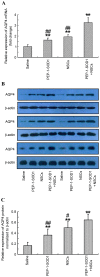Recombinant PEP-1-SOD1 improves functional recovery after neural stem cell transplantation in rats with traumatic brain injury
- PMID: 29599832
- PMCID: PMC5867477
- DOI: 10.3892/etm.2018.5781
Recombinant PEP-1-SOD1 improves functional recovery after neural stem cell transplantation in rats with traumatic brain injury
Abstract
The transplantation of neural stem cells (NSCs) has been demonstrated as a potential treatment strategy for traumatic brain injury (TBI). Cu, Zn-superoxide dismutase (SOD1) is an important antioxidant enzyme that detoxifies intracellular reactive oxygen species, thereby protecting cells from oxidative damage. PEP-1, a peptide carrier, is able to deliver full-length native peptides or proteins into cells. Therefore, the current study investigated the effect of the transplantation of NSCs in combination with PEP-1-SOD1 for the treatment of experimental TBI in rats. Initially, the effect of PEP-1-SOD1 on the proliferation of NSCs was evaluated by MTT assay. PEP-1-SOD1 (0.5, 2.5 and 4.5 µM) significantly increased the proliferation rates of NSCs at 24, 48 and 72 h in a dose-dependent manner. PEP-1-SOD1 also promoted the differentiation of NSCs in vitro. The in vivo experiment showed that PEP-1-SOD1 in combination with NSC transplantation significantly improved the functional recovery of rats following TBI compared with NSC transplantation alone. A significant increase in brain aquaporin-4 (AQP4) mRNA and protein expression levels was observed 4 days post-TBI in PEP-1-SOD1, NSCs and PEP-1-SOD1 + NSCs groups compared with the saline group. The PEP-1-SOD1 + NSCs group showed a further increase of AQP4 mRNA and protein expression levels compared with the NSCs and PEP-1-SOD1 groups. In conclusion, the current data suggests that PEP-1-SOD1 may promote the proliferation and differentiation of NSCs, and thereby improve the functional recovery of TBI model rats following NSCs transplantation through upregulating the expression of AQP4.
Keywords: aquaporin-4; neural stem cells; superoxide dismutase; traumatic brain injury.
Figures





Similar articles
-
Systemic administration of PEP-1-SOD1 fusion protein improves functional recovery by inhibition of neuronal cell death after spinal cord injury.Free Radic Biol Med. 2008 Oct 15;45(8):1190-200. doi: 10.1016/j.freeradbiomed.2008.07.016. Epub 2008 Jul 27. Free Radic Biol Med. 2008. PMID: 18722523
-
Neural stem cells genetically modified to overexpress cu/zn-superoxide dismutase enhance amelioration of ischemic stroke in mice.Stroke. 2012 Sep;43(9):2423-9. doi: 10.1161/STROKEAHA.112.656900. Epub 2012 Jun 19. Stroke. 2012. PMID: 22713489 Free PMC article.
-
Transplantation of neural stem cells enhances expression of synaptic protein and promotes functional recovery in a rat model of traumatic brain injury.Mol Med Rep. 2011 Sep-Oct;4(5):849-56. doi: 10.3892/mmr.2011.510. Epub 2011 Jun 16. Mol Med Rep. 2011. PMID: 21687946
-
Docosahexaenoic acid (DHA) enhances the therapeutic potential of neonatal neural stem cell transplantation post-Traumatic brain injury.Behav Brain Res. 2018 Mar 15;340:1-13. doi: 10.1016/j.bbr.2017.11.007. Epub 2017 Nov 7. Behav Brain Res. 2018. PMID: 29126932
-
Stem cells for therapy in TBI.J R Army Med Corps. 2016 Apr;162(2):98-102. doi: 10.1136/jramc-2015-000475. Epub 2015 Sep 3. J R Army Med Corps. 2016. PMID: 26338987 Review.
Cited by
-
Cu,Zn-Superoxide Dismutase has Minimal Effects Against Cuprizone-Induced Demyelination, Microglial Activation, and Neurogenesis Defects in the C57BL/6 Mouse Hippocampus.Neurochem Res. 2023 Jul;48(7):2138-2147. doi: 10.1007/s11064-023-03886-z. Epub 2023 Feb 20. Neurochem Res. 2023. PMID: 36808020
-
[Cell membrane-penetrating capacity of hPP10-Cu, Zn-SOD fusion protein and its antioxidant and anti-inflammatory activity].Nan Fang Yi Ke Da Xue Xue Bao. 2024 Jun 20;44(6):1059-1069. doi: 10.12122/j.issn.1673-4254.2024.06.06. Nan Fang Yi Ke Da Xue Xue Bao. 2024. PMID: 38977335 Free PMC article. Chinese.
-
Fast-tracking regenerative medicine for traumatic brain injury.Neural Regen Res. 2020 Jul;15(7):1179-1190. doi: 10.4103/1673-5374.270294. Neural Regen Res. 2020. PMID: 31960797 Free PMC article. Review.
-
Linc-NSC affects cell differentiation, apoptosis and proliferation in mouse neural stem cells and embryonic stem cells in vitro and in vivo.Cell Mol Life Sci. 2024 Apr 14;81(1):182. doi: 10.1007/s00018-024-05224-0. Cell Mol Life Sci. 2024. PMID: 38615283 Free PMC article.
-
Models of traumatic brain injury-highlights and drawbacks.Front Neurol. 2023 Jun 15;14:1151660. doi: 10.3389/fneur.2023.1151660. eCollection 2023. Front Neurol. 2023. PMID: 37396767 Free PMC article. Review.
References
-
- Ma H, Yu B, Kong L, Zhang Y, Shi Y. Transplantation of neural stem cells enhances expression of synaptic protein and promotes functional recovery in a rat model of traumatic brain injury. Mol Med Rep. 2011;4:849–856. - PubMed
LinkOut - more resources
Full Text Sources
Other Literature Sources
Miscellaneous
